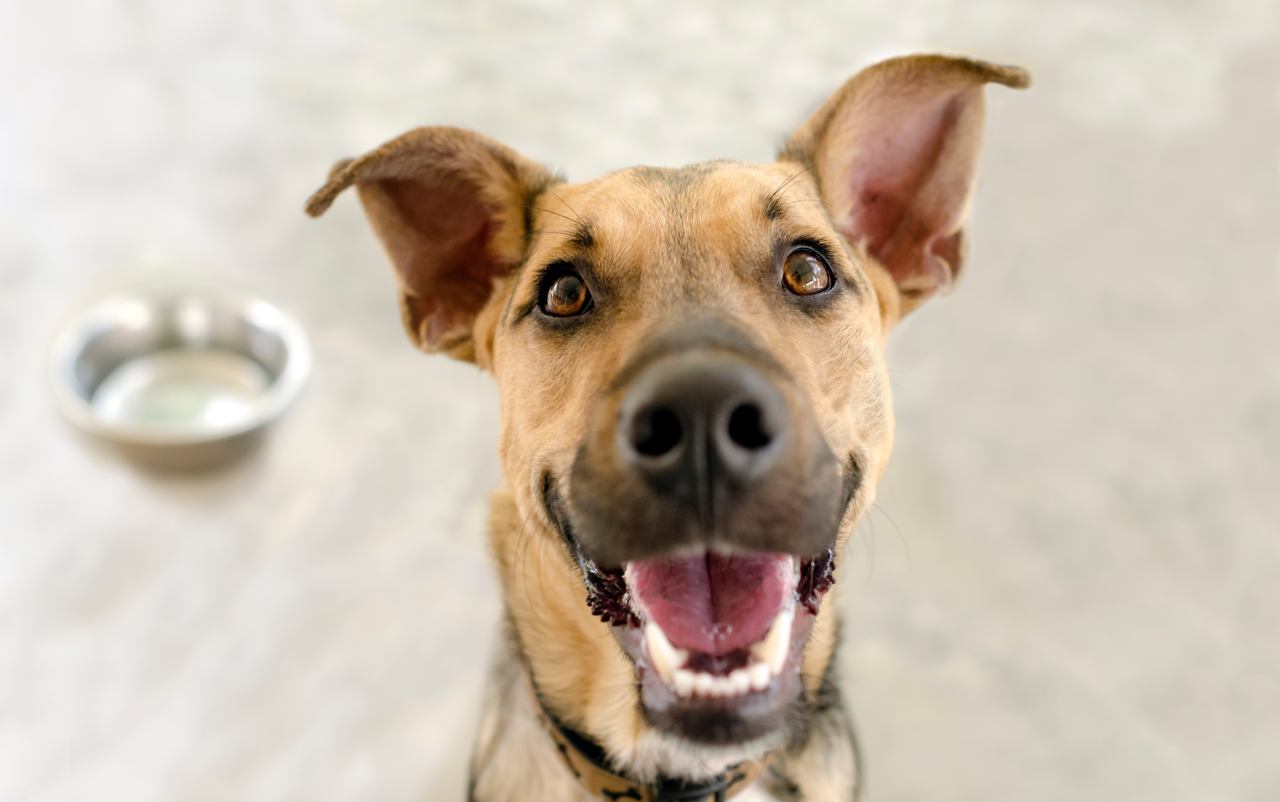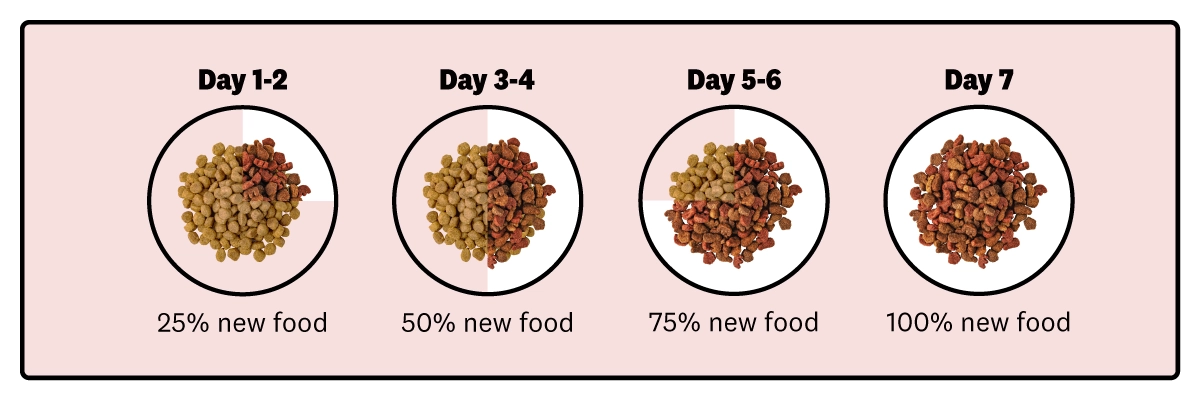
Transition Your Pet Onto a New Food
Nutrition is the key to a happy, healthy pet, but there may be instances where you’re required to make a change to your pets diet. This may be that they've turned their noses up to their current food, there's a food formula change, they're going through a life stage shift, or needing a specific health issue addressed. But don't go throwing out that bag of pet food in the pantry just yet, it's important to not rush into things when switching out their diet!
Here's a look into how to make the transition as smooth as possible.
Reasons for changing to new pet food
Like us hoomans, your pet may require adjustments to their diet throughout their life to keep them at their best. Sometimes this may be because your pet no longer likes their current bowl of kibble or your wee furry friend is now an big furry adult (change in life stage). Chat to your vet to understand when might be a good time to transition your pet to a new food. Other common factors that your vet may recommend a transition can include:
New pet
You've made the decision to bring a new furry member to the family - how a-meow-zing! Before you bring a new pet home, you will need to prepare for their arrival (read our Kitten Guide or Puppy Guide), which includes having food ready for their hungry mouths. It's a good idea to initially continue feeding the food that your pet was fed in their previous home or adoption centre as long as it is nutritionally complete and balanced. Make sure you ask what diet the your pet has been on - think wet, dry, chicken, fish, any allergies, etc.. This will help you to understand what your pet is used to eating, what they like, and what they may not like.
It's important to remember that moving to a new home can be a lot of stress on its own for a puppy, kitten or any new pet, so it is a good idea to hold off on switching their diet until they have fully settled in and you have visited your veterinarian to ensure that they don’t require a specific diet. Check with the adoption centre or breeder beforehand what diet they are on before picking up your new pet so you can purchase their current food to help them settle into your home.
Life stage
As your puppy or kitten develops into an adult, there will come a time to transition them onto an appropriate diet to meet their changing nutritional needs and growing bodies. Some diets however will be suitable for all life stages so they may be able to continue with the same food. Check with your vet if this may be the case and whether you may need to supplement their diet (for example, senior pets may need additional joint care).
Food Formula Changes
When it comes to a change to the formula in your pet's regular food, it's crucial to approach the transition thoughtfully and with care. Whether due to a change in ingredients or an updated formulation, abruptly switching your pet's food can lead to digestive discomfort and potential health issues. That's why it's highly recommended to introduce the new formula gradually. By gradually changing to the new formulation, it prevents the likeliness of gastrointestinal upset or ther reactions. If you are unsure about formulation changes in your pet's diet, you can get in touch with your regular vet to ensure their food meets their dietary needs.
Variety
If your pet is no longer interested in eating what's in their bowl, you may want to switch up their diet to add variety to their mealtime. There are so many types of dog food and cat food available, including dry, wet, freeze dried & dehydrated, fresh and raw. It is important when choosing your pet’s food that all their nutritional needs are met and they are receiving a complete and balanced diet. Cats and dogs both need appropriate amounts of protein, carbohydrates, fats, minerals and vitamins. These are all extremely important for your pet’s health and wellbeing. Once you have identified a brand and formula that is working well for your pet, you can start to mix things up to keep their meal times interesting. Chat with your vet if you are thinking of adding variety to their diet.
Health concerns
Just like us humans, pets can also develop allergies and sensitivities. These can be environmental or food-related. Many pet owners find that feeding a limited ingredient dog or cat food or even a grain-free diet for their dog or cat can help with their allergies or sensitivities. Common food allergies include beef, dairy, wheat and chicken. If you are concerned that your cat or dog may have a food allergy, speak with your vet. An elimination diet can help pinpoint any specific allergens. After that you will be able to choose the food that will be best for your pet.
Weight control may also be another factor in wanting to switch their diet. Some causes of weight gain are preventable in cats and dogs such as lack of exercise and overfeeding, while other causes are unavoidable. Older pets, less active pets, spayed or neutered pets and female pets are more prone to experience weight gain. Your dog or cat may require a weight management formula to help them maintain a healthy weight. If your pet is underweight, they may also require a special diet. Always consult with your vet when it comes to any weight concerns.
Every pet has unique needs, and sometimes those needs can require a vet diet (sometimes called prescription diets). These formulas can help pet food allergies, hairball control issues, breed specific or breed size needs, hip and joint health, skin and coat health, activity levels, indoor cat needs, weight management, sensitive stomach or oral health. Your vet may recommend certain a diet for your pet based on the health conditions your vet has diagnosed them with.
Transitioning to new food
If you've planned for your big bag of dry food to conincide with the arrival of a new bag of new food, best to think again. Some pets can tolerate the sudden change of food without too many issues, but often swtiching your pet's food can lead to an upset stomach, diarrhoea, increased gas, and nausea. Sometimes your pet may just not want to eat the new stuff.
To switch their food over successfully, it's best to have a gradual transition to a new food to help avoid any unwelcome tummy trouble! It is important to slowly introduce new foods into your pet's diet as their new diet may have quite different ingredients, levels of nutrients such as protein, fibre, and fat. This is especially important if you want to switch your pet from a grain inclusive to a grain free food, or you go from wet to dry food and vice versa. It can be common to see some changes in your pets toileting output and consistency.
Be sure to keep an eye out for any significant changes in your pets poop or signs of digestive upset. If these do not subside within a couple of weeks with a slow transition onto the new food, it is best to seek advice from your veterinarian who will help you decide what's best for your pet.
When introducing new food to your pet, you should mix their old food with their new food over a week period depending on the switch - your vet will be able to provide guidance with this. Start off with a small amount mixed in, then gradually increase the ratio of new food to old food over time without increasing the amount of food given. For example, if you feed 1 cup of food daily to your dog, keep feeding them 1 cup with differing combination of old and new food to make up that 1 cup.
Here’s an example of how this would look:
Day 1-2: Feed 1/4 cup of the new food mixed with 3/4 cup of the current food (25% new food)
Day 3-4: Feed 1/2 cup of the new food and 1/2 cup of the current food (50% new food)
Day 5-6: Feed 3/4 cup of new food and 1/4 cup of current food (75% new food)
Day 7+: Feed 1 full cup of the new food (100% new food)
If there are no negative affects by the end of the week, your pet will have successfully transitioned to their new food.

What to look out for
Some common issues to look out for when transitioning to a new food are soft stools, vomitting, or refusal to eat. If you notice any of these issues, consult your vet and revert back to day 1 of the transition schedule. If the problem continues, you may need to go back ot the old food for a while before starting the whole transition again - patience is the key.
After a week on their old food without any issues, begin transitioning again to the new food BUT try smaller amount of new food to old food for a longer period - see example below:
Day 1-4: Feed 1/8 cup of the new food mixed with 7/8 cup of the current food
Day 5-7: Feed 1/4 cup of the new food and 3/4 cup of the current food
Day 8-12: Feed 1/2 cup of new food and 1/2 cup of current food
Day 12+13: Feed 3/4 cup of the new food and 1/4 of current food
Day 14+: Feed 1 cup full of the new food
Cats can be a little more picky when switching food as they may actually prefer wet food over dry food or have a preference for the square kibble than the round one.
Ensure that your pet is eating throughout the transition. If you notice they are not eating or continue having issues with transitionining to new food, chat to your vet and see what they recommend.
Types of food out there
We're spoilt for choices when it comes to cat and dog food. There are so many different claims - grain-free, natural, premium food, freeze-dried - but what does it all mean. It helps to understand what the basic nutritional needs of cats and dogs are (read more on Dog Nutrition Basics and Cat Nutrition Basics) and from there chat to your vet on:
- Wet vs dry food options
- Natural vs. science-based diets
- Freeze dried options, supplements and toppers
Read more on the differences here.